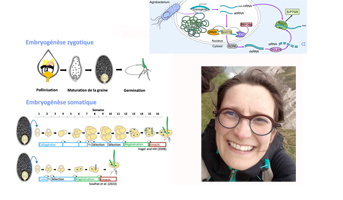IJPB Highlights from Life Sciences at Paris-Saclay University
Portrait - Aline Voxeur, a research scientist in glycobiology, 18/04/23
Aline Voxeur joined INRAE in 2020 as a research scientist the "Glycans and Signaling" GAS team at IJPB. She works on the structural characterization and role of oligosaccharides in regulating growth and defense mechanisms in plants.
> More
> See also IJPB news 19/01/23
A fast track for genetic transformation and genome editing of a cereal model plant, 12/04/23
CRISPR/Cas9 technology facilitates functional analysis of genes, leading to a wide range of applications in plants and animals. In plants, this technology in most cases requires in vitro culture of plant tissues to regenerate the edited individuals. In an article published in the journal Plant Methods, researchers from the IJPB Cell Biology and Regeneration" BCR and "Nitrogen Use, Transport and Signaling" NUTS teams conducted a study on Brachypodium distachyon, a model plant close to wheat and barley and used by a large international community to unravel the biological mechanisms of regeneration and manage to cut its time by half.
> More
Synergistic action of the Arabidopsis spliceosome components PRP39a and SmD1b in promoting post-transcriptional transgene silencing, 04/04/23
The conserved spliceosome component SmD1b not only regulates splicing but also promotes posttranscriptional silencing of sense transgenes (S-PTGS) (Elvira-Matelot et al., 2016). In a recent study published in The Plant Cell, the IJPB "Epigenetics and small RNA" EpiARN team, in collaboration with the Institute of Plant Sciences Paris-Saclay (IPS2) and the Max Plank Institute (Germany) shows that the conserved spliceosome component PRP39a also plays a role in S-PTGS in Arabidopsis thaliana.
> More: news IJPB 30/03/23
Back
